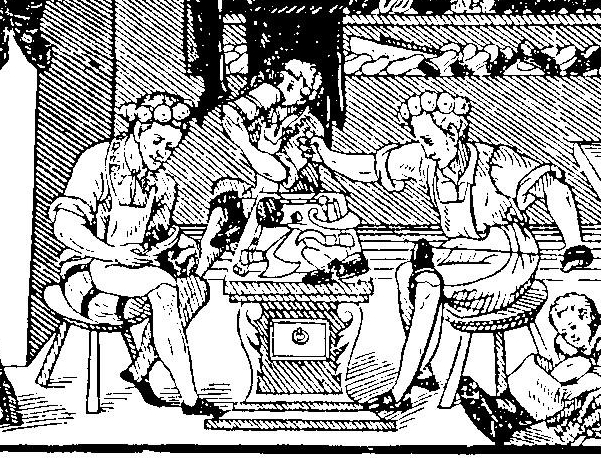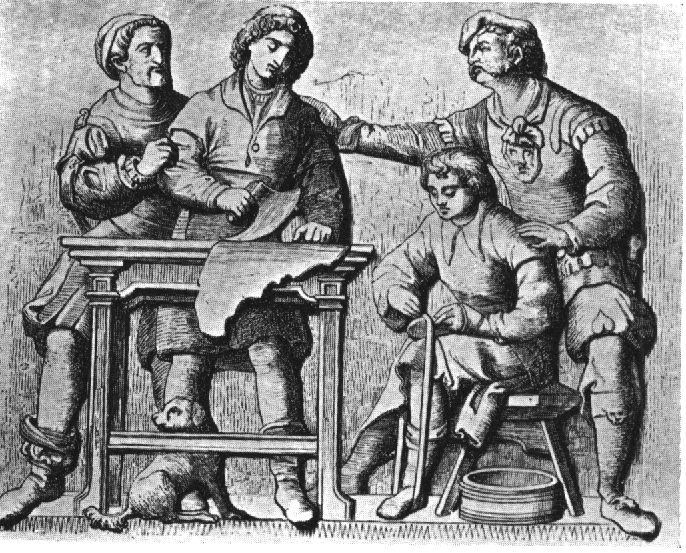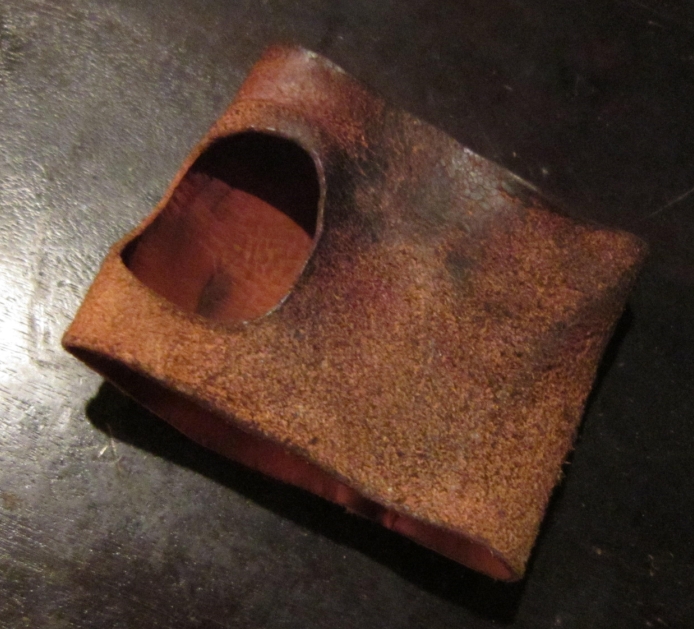As part of shoemaking, when closing an upper or inseaming, one has to pull two ends of your stitching cord tight. Many of the illustrations show a shoemaker in the process of swinging their arms out to pull their stitches tight. But, as you might imagine, this repeated action of pulling tightly on stitching cords against bare skin can wear down the skin, causing blisters and cuts. The palm, or hand leather, is typically worn on the left hand and is used protect the shoemaker from the constant stress of tugging stitches tight. In this 16th Century German sculpture of St. Crispin and St. Crispianus, altar figures from the shoemaker’s altar in the Marien Church in Delitzsch, a palm is visible on the left hand (what may look like a narrow palm on the right is actually the cuff of the sleeve).
Interestingly enough, evidence for hand leathers in the medieval arena is somewhat scant.
There is a leather mitt in the Museum of London (I cannot find my pictures, so you’ll have to take my word for it), but I have been unable to find any evidence for using a palm in paintings or other iconographic sources before the 16th century. Even so, it seems logical that they would have used some kind of hand protection while pulling stitches tight. The images we do have start from the 16th century. We do have some possible evidence of the use of hand leathers from the 15th century British Library, MS Harl. 1002. f.113.r. Extracted from Thomas Wright’s “A Volume of Vocabularies,” the word “impedia” here is used, and is translated as “over-leather.” This could possibly refer to a hand leather, as most of the other description are parts of shoes or shoemaking tools.
A detail of a shoemaker’s shop, the image from the Germanisches Nationalmuseum, shows the worker using a hand leather on his left hand.
A picture of the sculpture “SS. Crispin and Crispianus arrested by the Roman Soldiers” by Francois Gentil, end of 16th Century, in church of St. Pantaleon,Troyes, France is shown here (from photo by Mr.Geo. Avenell, from Thomas Wright’s Romance of the Shoe, 1923). Again, my thanks to Marc Carlson’s site for the excellent research images.
This is all well and good, you might say, but practically speaking, how is the palm actually to be used? Great question – we really don’t have a lot of detail until we get to 18th century sources like Garsault mentioned above. However, I would also suspect that each shoemaker’s shop might have had slight variations to their technique. So, briefly, I will describe the way that I use my palm when closing an upper. The same goes for inseaming as well.
So, we’ve pierced our awl hole and threaded each end of the stitching cord through. We have also pulled them through the awl hole, but have not tightened the stitch yet. Note that I do not put down my awl or put down the waxed ends, because it takes time to pick them up again, and time spent picking up your tools and putting them down is time spent not making shoes. =) Instead, while holding the right waxed end and awl in my right hand, I twist the cord on the bottom of the knob of the awl as shown below.
Then, once I have wrapped the right side cord around the awl, while holding the left waxed end with the left hand, I wrap the left side stitching cord around my palm. With this done, I can then pull the cords firmly and make the stitch tight.
In truth, this is much more easily shown in a video than with pictures, so I may end up doing a post on closing – that will certainly give a better idea of the movements and such.




